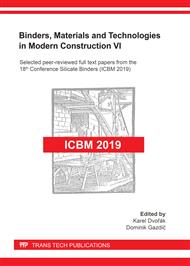[1]
Sokolar, R. Effect of calcite on the brick body closing. InterCeram 59 (2010), pp.123-127.
Google Scholar
[2]
Matejka, J., Nikitin, A. Effect of firing temperature on the important properties of ceramic bodies. Stavivo 11 (1930), pp.219-333 (in Czech).
Google Scholar
[3]
Matejka, J. Progress of natural process of clay roof tiles closing on the roofs. Stavivo 13 (1932), pp.24-27 (in Czech).
Google Scholar
[4]
Emmons, P., Concrete Repair and Maintenance Illustrated: Problem Analysis, Repair Strategy, Techniques. RSMeans, (1992).
Google Scholar
[5]
Garg, N., Wang, K., Martin, S.W. A Raman spectroscopic study of the evolution of sulfates and hydroxides in cement-fly ash pastes, Cement and Concrete Research 53 (2013) p.91 – 103.
DOI: 10.1016/j.cemconres.2013.06.009
Google Scholar
[6]
Kuder, K., Lehman, D., Berman, J., Hanesson, G., Shrogen,R. Mechanical properties of self consolidating concrete blended with high volumes of fly ash and slag. Construction and Building Materials 34 (2012), pp.285-295.
DOI: 10.1016/j.conbuildmat.2012.02.034
Google Scholar
[7]
Uysal, M., Akyuncu, V. Durability performance of concrete incorporating class F and class C fly ashes. Construction and Building Materials 34 (2012), pp.170-178.
DOI: 10.1016/j.conbuildmat.2012.02.075
Google Scholar
[8]
De La Varga, I., Castro, J., Bentz, D., Weiss, J. Application of internal curing for mixtures containing high volumes of fly ash. Cement and Concrete Composites 34 (2012), pp.1001-1006.
DOI: 10.1016/j.cemconcomp.2012.06.008
Google Scholar
[9]
Guo, X., Shi, H., Dick, W.A. Compressive strength and microstructural characteristics of class C fly ash geopolymer. Cement and Concrete Composites 32 (2010), pp.142-147.
DOI: 10.1016/j.cemconcomp.2009.11.003
Google Scholar
[10]
Guo, X., Shi, H., Ghen, L., Dick, W.A. Alkali-activated complex binders from class C fly ash and Ca-containing admixtures. Journal of Hazardeous Materials 173 (2010), pp.480-486.
DOI: 10.1016/j.jhazmat.2009.08.110
Google Scholar
[11]
Misra,A., Biswas, D., Upadhyaya, S. Physico-mechanical behavior of self-cementing class C fly ash-clay mixtures. Fuel 84 (2005), pp.1410-1422.
DOI: 10.1016/j.fuel.2004.10.018
Google Scholar
[12]
R. Sokolar, L. Smetanova, Dry pressed ceramic tiles based on fly ash–clay body: Influence of fly ash granulometry and pentasodium triphosphate addition. Ceramic International 36 (2010), pp.215-221.
DOI: 10.1016/j.ceramint.2009.07.009
Google Scholar
[13]
S. Abbas, M. A. Saleem, S. M. S.K. Kazmi, M. J. Munir, Production of sustainable clay bricks using waste fly ash: Mechanical and durability properties. Journal of Building Engineering 14 (2017), pp.7-14.
DOI: 10.1016/j.jobe.2017.09.008
Google Scholar
[14]
R. Sokolar, M. Nguyen. The fly ash of class C for ceramic technology. Materials Science and Engineering. 385 (2018), pp.1-6.
Google Scholar
[15]
Andrade, F., A., Al-Qureshi, H., A., Hotza, D., Measuring the plasticity of clays: A review. Applied Clay Science,. 51 (2011), p.1 – 7.
DOI: 10.1016/j.clay.2010.10.028
Google Scholar


